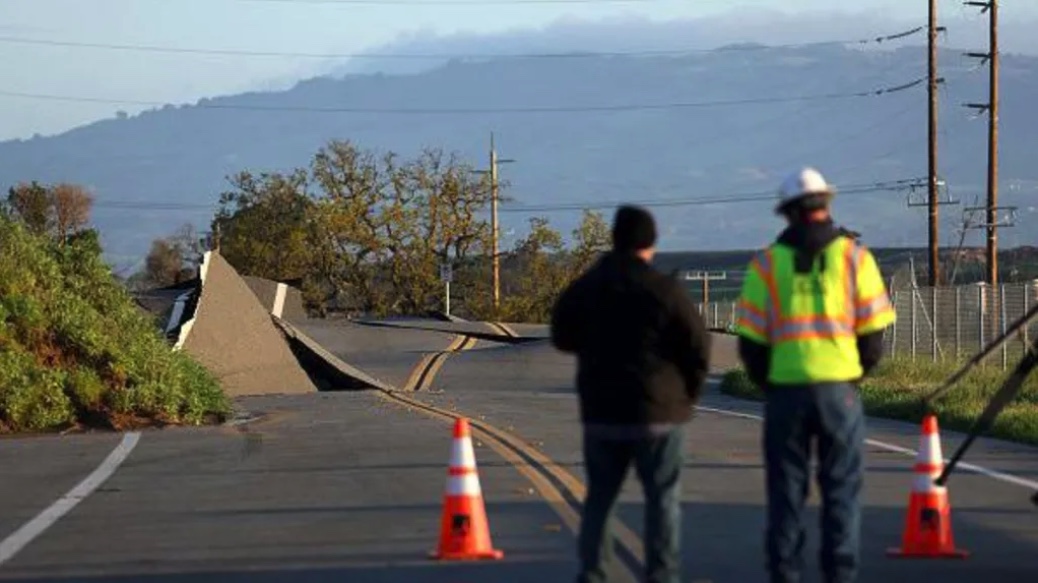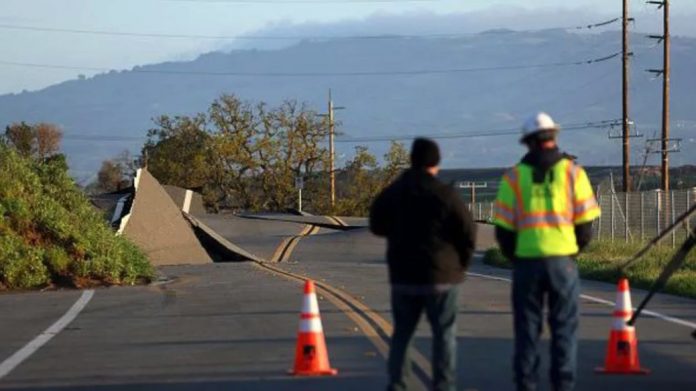พายุที่กำลังพัฒนานอกชายฝั่งตะวันตกเฉียงเหนือของสหรัฐฯ คาดว่าจะนำลมแรง น้ำท่วม และหิมะมาสู่ประชากรกว่า 7 ล้านคนในรัฐที่ติดมหาสมุทรแปซิฟิก
สำนักงานบริหารมหาสมุทรและชั้นบรรยากาศแห่งชาติสหรัฐฯ (NOAA) รายงานว่า พายุได้เริ่มส่งผลกระทบต่อภูมิภาคดังกล่าวตั้งแต่วันอังคาร และมีแนวโน้มจะแรงขึ้นจนถึงสิ้นสัปดาห์
นอกจากลม ฝน และหิมะแล้ว พายุยังอาจก่อให้เกิดน้ำท่วมฉับพลัน ดินถล่ม และการไหลของเศษซาก รวมถึงหิมะหนาในภูเขาและสภาพพายุหิมะในพื้นที่สูง
พายุ “Bomb Cyclone” ซึ่งเป็นชื่อที่นักพยากรณ์อากาศใช้เรียก เกิดจากความกดอากาศลดลงอย่างรวดเร็วใกล้ชายฝั่ง ทำให้สภาพอากาศรุนแรงขึ้นอย่างมาก
พายุจะส่งผลเมื่อใดและที่ไหนบ้าง?
บางส่วนของภาคตะวันตกเฉียงเหนือเริ่มได้รับผลกระทบจากพายุแล้ว โดยมีรายงานลมกระโชกแรงในเขตซีแอตเทิล
ศูนย์พยากรณ์อากาศ NOAA คาดว่าพายุจะนำหิมะเปียกหนักไปยังแนวเทือกเขาในแถบแปซิฟิกตะวันตกเฉียงเหนือ โดยหิมะจะสะสมในอัตรา 5-8 เซนติเมตรต่อชั่วโมง และลมแรงสูงสุดถึง 65 ไมล์ต่อชั่วโมง (ประมาณ 105 กิโลเมตรต่อชั่วโมง)
NOAA เตือนว่าสภาพอากาศอาจทำให้การเดินทางยากลำบากในพื้นที่ที่เกิดพายุ โดยบางพื้นที่อาจมีหิมะสะสมถึง 25-50 เซนติเมตร
ลมกระโชกแรงอาจทำให้ไฟฟ้าดับ ต้นไม้หักโค่น และคลื่นสูงตามแนวชายฝั่ง NOAA ยังออกคำเตือน “ความเสี่ยงสูงจากฝนตกหนักเกิน” สำหรับพื้นที่ทางตะวันตกเฉียงเหนือของรัฐแคลิฟอร์เนีย
ส่วนปริมาณฝนที่หนักที่สุด ซึ่งอาจก่อให้เกิดดินถล่ม คาดว่าจะเกิดในแถบตอนเหนือของรัฐแคลิฟอร์เนียและตะวันตกเฉียงใต้ของรัฐโอเรกอน
บริการอากาศแห่งชาติยังออกคำเตือนเรื่องสภาพอากาศฤดูหนาวและคำเตือนพายุหิมะจนถึงวันพุธสำหรับหลายพื้นที่ตามแนวชายฝั่งแปซิฟิก
“น้ำท่วมฉับพลันจำนวนมาก การเดินทางที่อันตราย ไฟฟ้าดับ และความเสียหายของต้นไม้สามารถเกิดขึ้นได้เมื่อพายุถึงจุดรุนแรงที่สุด” ศูนย์พยากรณ์อากาศแห่งชาติระบุในโพสต์บน X (Twitter เดิม)
Bomb Cyclone คืออะไร?
Bomb Cyclone เป็นคำที่นักอุตุนิยมวิทยาใช้เรียกพายุที่ทวีความรุนแรงอย่างรวดเร็ว โดยมีความกดอากาศลดลงอย่างน้อย 24 มิลลิบาร์ภายใน 24 ชั่วโมง
พายุเหล่านี้ถูกเรียกว่า “Bomb” เพราะพลังอันรุนแรงที่เกิดจากการลดลงของความกดอากาศอย่างรวดเร็ว
พายุ Bomb Cyclone สามารถสร้างสภาพอากาศหลากหลาย ตั้งแต่พายุหิมะจนถึงพายุฝนฟ้าคะนองรุนแรง และฝนตกหนัก
เฮเลน รอสซิงตัน นักพยากรณ์อากาศของ BBC Weather กล่าวว่า พายุ Bomb Cyclone จะเริ่มด้วยลมแรง ฝน และหิมะในชายฝั่งตะวันตกเฉียงเหนือ ก่อนที่ภูมิภาคดังกล่าวจะเผชิญฝนตกหนัก หิมะในภูเขา และความเสี่ยงน้ำท่วมอย่างต่อเนื่อง
เหตุการณ์เหล่านี้ไม่ใช่เรื่องผิดปกติสำหรับช่วงเวลานี้ของปี โดยเฉพาะเมื่อมี “แม่น้ำในชั้นบรรยากาศ” ซึ่งเป็นบริเวณความชื้นเล็ก ๆ ที่เคลื่อนตัวมาจากเขตร้อน
แต่เมื่อแม่น้ำในชั้นบรรยากาศมารวมกับพายุ Bomb Cyclone อาจทำให้เกิดเหตุการณ์สภาพอากาศครั้งใหญ่ได้
‘Bomb cyclone’ to bring rain, snow and winds to US northwest.

A storm developing off the coast of the US northwest is forecast to bring high winds, flooding and snow to over seven million residents living in states along the Pacific Ocean.
It started impacting the region Tuesday and is expected to worsen through the end of the week, according to the National Oceanic and Atmospheric Administration (NOAA).
Beyond wind, rain and snow, the storm could also bring flash flooding, rock slides and debris flows as well as heavy mountain snow and blizzard conditions in areas of high elevation.
The “bomb cyclone” – as forecasters call it – is caused by air pressure quickly dropping off the coast, which has rapidly intensified the weather system.
When and where will it hit?
Parts of the northwest are already starting to feel impacts from the storm, with strong wind gusts already observed in the Seattle area.
NOAA’s weather prediction centre said the storm is expected to bring heavy, wet snow to mountain ranges in the Pacific Northwest with accumulation rates of 2-3in (5-8cm) per hour and wind up to 65 mph (29mps).
The weather could bring whiteout conditions that will make travel difficult, according to NOAA. There could be 10-20in (25-50cm) of snow in spots.
Wind gusts could bring power outages, downed trees and high surf along the coastline, the US weather agency said, which issued a “high risk excessive rainfall outlook” for northwest California.
The heaviest rainfall – which could bring mud slides – is expected to hit northern California and southwest Oregon, according to the NOAA.
The National Weather Service also issued winter weather alerts and a winter storm warning through Wednesday for several other areas along the Pacific coast.
“Numerous flash floods, hazardous travel, power outages, and tree damage can be expected as the storm reaches max intensity,” the National Weather Prediction Centre wrote in a post on X.
What is a bomb cyclone?
Bomb cyclone is a term given by meteorologists to a storm that appears to intensify rapidly, with its central air pressure dropping to at least 24 millibars in 24 hours.
They are referred to as ‘bomb’ cyclones due to the explosive power of these storms caused by the rapid fall in pressure.
The storm brings with it an array of weather, ranging from blizzards to severe thunderstorms to heavy precipitation.
BBC Weather forecaster Helen Rossington has said that the bomb cyclone will first deliver strong winds, rain and snow to the north-west coast before the region is walloped by a prolonged spell of heavy rain, mountain snow and flood risk.
These weather events are not unusual for this time of year.
Similar atmospheric river events – when small regions of moisture travel outside tropical regions – have occurred throughout North America over the last few weeks.
But the conditions of an atmospheric river combined with a bomb cyclone can create a major weather event.
Rachel Looker, BBC News

















